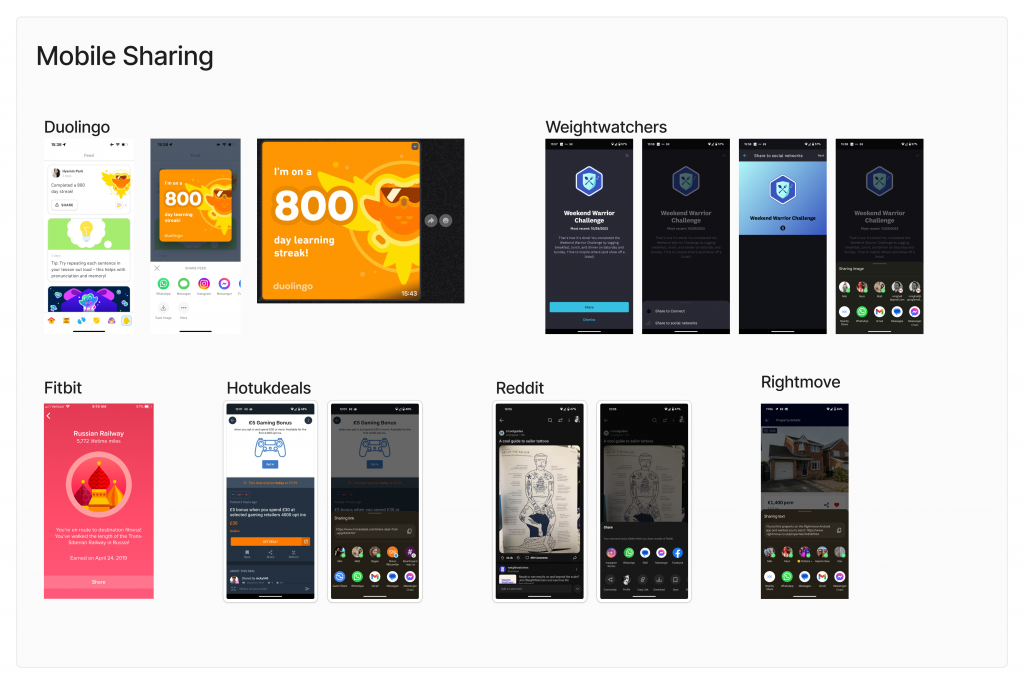Encouraging research participants to share their involvement
Role: Lead product designer
Company: Our Future Health
Product Type: Web application
Background
- Ideation with the user-centred design team identified alternative routes of growth outside of the main sign up journey
- One of these was around participant word-of mouth
How might we encourage participants to share their participation and invite people they know to join the programme?
Problem
We aimed to support research participants to share their involvement through social media to:
- Increase awareness and engagement with the research program
- Foster a sense of pride and ownership among participants
- Attract new participants by showcasing the community’s enthusiasm.
Discovery
Stakeholder and participant interviews
To understand the requirements, I conducted interviews with stakeholders and participants. These conversations highlighted key insights:
- Participants wanted to share their involvement in a way that felt authentic and celebratory
- Stakeholders emphasised the importance of maintaining privacy and ensuring compliance with ethical guidelines.
Comparative analysis
I analysed sharing patterns used on popular websites and apps, including Facebook, Instagram, and LinkedIn, to identify best practices for encouraging social sharing while safeguarding participant data.
This included exploring how platforms balance ease of use with privacy and ethical considerations. This included exploring how platforms balance ease of use with privacy and ethical considerations. Key findings included:
- Simplified sharing processes: platforms like Instagram and Facebook streamline sharing with one-click options, reducing friction for users
- Customisable content: LinkedIn allows users to personalise shared posts, adding their own voice to pre-designed templates
- Privacy safeguards: clear explanations of what data is shared and with whom, as seen on Facebook’s privacy settings, are essential for building trust.
These insights informed the design of Our Future Health’s social sharing feature.
Ideation and design
Concept development
Based on research findings, I proposed a feature allowing participants to share their involvement directly from their dashboard. Key elements included:
- Customisable templates: Pre-defined messaging with the option for the participant to customise if they wished to
- Reassurance on privacy: So that the participant could be confident none of their personal information would be shared
- Preview functionality: To ensure participants were comfortable with the content before posting.
UI design
The designs adhered to Our Future Health’s branding, incorporating:
- Bright, engaging visuals to celebrate participant achievements
- Common patterns that are well established with users
- The use of device native behaviour, so that users are interacting with a familiar interface
- Accessibility considerations, including sufficient contrast and alt text for graphics
- Collaboration with a content designer to ensure the messaging in templates and prompts was clear, engaging, and aligned with user needs.
Experimentation
AB Testing
As this was a simple tool, we decided to forgo usability testing and proceed directly to A/B testing. The objectives were to:
- Measure whether participants used the tool.
- Determine which messaging templates performed best in terms of engagement and sharing rates.
The tests provided actionable insights, helping refine the messaging and functionality to better align with user preferences. Overall the usage rate of the tool was high, so we decided to roll out to 100% of traffic.
Results and impact
Referred participants
Of those consented
Completed all tasks
Since its launch in September, the social sharing feature has demonstrated tangible impact:
- Participation Growth: 1,291 referred participants registered through shared posts.
- Consent Rates: Of these, 958 participants (74.2%) provided consent, showcasing the trust built through the process.
- Engagement Conversion: 530 participants have already transitioned to full participation, indicating the feature’s effectiveness in driving deeper involvement.
These metrics underline the feature’s success in fostering community engagement and enhancing the participant journey.
Future plans include expanding template options and integrating sharing prompts into other participant touchpoints.






